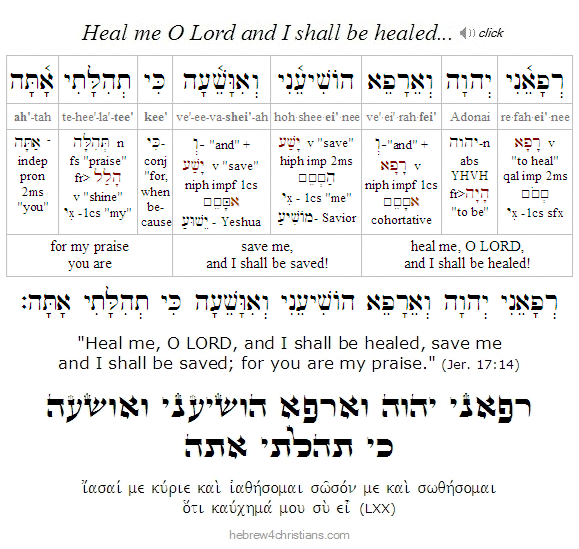|
Atonement is about righting the wrong that separates us from God, repairing the breach caused by our sin, and being healed from the curse of death. We all desperately need this healing, yet our own hearts are the source of the trouble (Matt. 15:19-20). The holiness and justice of God (ЧђЧњЧ”ЦґЧ™Чќ) requires that sin be punished by death, but God is also merciful and gracious (Ч™Ч”Ч•Ч”), and therefore He instituted a system of animal sacrifices and blood rituals to provisionally "atone" for sin (i.e., restore the broken relationship with God). Since the life of the flesh is in the blood (Lev. 17:11), and the penalty for sin is death, the shedding of blood represents atonement (Ч›ЦјЦ·Ч¤ЦјЦёЧЁЦёЧ”) for sin. With regard to the chatat ("sin offering") or asham ("guilt offering"), a person would bring a kosher animal (korban) to the entrance of the Tabernacle and place both hands on the animal's head to identify with it (Lev. 4:29). This act of "semikhah" (ЧЎЦ°ЧћЦґЧ™Ч›ЦёЧ”) symbolically (i.e., ritually) transferred the penalty of sin and guilt to the sacrificial animal. Then, the person would slay the animal and confess that his sin caused the innocent to be slain in his place (Menachot 110a). The elaborate sacrificial system was intended to depict this "life-for-life" principle: God accepted the blood of a sacrifice in exchange for the life of the sinner...
The sacrificial system of the Tabernacle was a temporary arrangement until the coming of Messiah, the Promised Deliverer (Gal. 3:24-25; Rom. 10:4; Heb. 9:1-12). The redemption obtained by animal sacrifices was merely provisional and symbolic, "for it is impossible for the blood of bulls and goats to take away sins" (Heb. 10:4). For eternal remedy, for the spiritual life of the soul, something far greater was needed, namely, the sacrifice of God Himself. Consequently, when Yeshua came into the world, he said, "Sacrifices and offerings you have not desired, but a body have you prepared for me," and "'Behold, I have come to do your will, O God, as it is written of me in the scroll of the book" (Heb. 10:5,7). All this is profoundly mysterious, of course. After all, if the Kohen Gadol (High Priest) could enter the Holy of Holies only once a year to present sacrificial blood upon the kapporet, invoking the Divine Name YHVH, and interceding for God's mercy on behalf of the people, how much more mysterious is Messiah's intercession for us as he willingly shed his own blood and died in exchange for the curse of our sins (Gal. 3:13)? It was there - in the true Holy of Holies, the "greater and more perfect tabernacle not made with hands" (Heb. 9:11), where the blood of Yeshua was poured out to pay the penalty for our sins, and it was there that we are given eternal life and healing (2 Cor. 5:21). Yeshua is the true Temple of God and the Central Sacrifice of God given on our behalf. In ways we simply cannot fathom, the sacrificial death of Yeshua redeems us from the curse of death and makes us alive together with God. We draw near to God through Him alone; he alone is the true High Priest of God, the One who finishes the work of redemption on our behalf in the Temple of his body...
The New Testament teaches that Yeshua came to die "for our sins," to heal us from the plague of death (Heb. 7:27, 9:26; 1 John 3:5). Our sin separates us from God, but Messiah's sacrifice draws us near (Heb. 7:19). The message of the gospel is that the Voice of the LORD - the very Word spoken from between the cherubim above the kapporet (mercy seat) - "became flesh" (бЅЃ О»бЅ№ОіОїП‚ ПѓбЅ°ПЃОѕ бјђОібЅіОЅОµП„Ої) and "tabernacled among us" (бјђПѓОєбЅµОЅП‰ПѓОµОЅ бјђОЅ бјЎОјбї–ОЅ) for the purpose of becoming our substitutionary sacrifice for the guilt and defilement caused by our sins (John 1:1,14). Yeshua was "born to die" (Heb. 10:5-7), and his life was lived in relation to His sacrificial death (Mark 8:27-33). As the Apostle Paul put it: This is of "first importance": Yeshua was born to die for our sins, to make us right with God, and was raised from the dead to vindicate the righteousness of God (1 Cor. 15:3-4). His sacrificial death eternally draws us near to God, and we can come boldly before God's Presence on the basis of His shed blood for our sins...
The sacrificial system of Torah functions as a parable for us, or a metaphor of God's great redemptive plan revealed in the life and death of Yeshua. The Mercy Seat (kapporet) represents both the Throne of God (Heb. 4:16; 2 Kings 19:15) as well as the cross of Yeshua, where propitiation for our sins was made (Rom. 3:25). The glory of the Torah of Moses was destined to fade away (2 Cor. 3:3-11), just as its ritual center (i.e., the Tabernacle/Temple) was a shadow (ПѓОєО№бЅ±) to be replaced by the greater priesthood of Malki-Tzedek (Heb. 10:1; 13:10). Yeshua is the Goal and the "Goel" (i.e., Ч’ЦјЧђЦµЧњ, Redeemer) from the curse of the law (Gal. 3:13). "For the law made nothing perfect, but on the other hand, a better hope is introduced, and that is how we draw near (karov) to God" (Heb. 7:19). The sacrificial death of Yeshua caused the parochet of the Temple to be torn asunder, revealing that access to the Presence of God is now available for all who come to God trusting in the finished work of God's Son.
For more on this subject, see "Why the Sacrifices?" and "Yom Kippur and the Gospel."
Note: To this world, the idea of blood atonement for sin is about as popular as getting a root canal or learning that you have a terminal disease... Nevertheless it is all the more precious because it pertains to the deepest mysteries of God's love and healing for us. The ground of all reality, the "Substance" of all things, is God's redeeming love given in Yeshua. In the climactic Book of Revelation, the Lamb that was slain is seen in "the midst of the throne of God," the Heavenly Kapporet itself: "For the Lamb in the midst of the throne (П„бЅё бјЂПЃОЅбЅ·ОїОЅ П„бЅё бјЂОЅбЅ° ОјбЅіПѓОїОЅ П„Оїбї¦ ОёПЃбЅ№ОЅОїП…) will be their shepherd, and he will guide them to springs of living water, and God will wipe away every tear from their eyes" (Rev. 7:17).
Hebrew Lesson
Jeremiah 17:14 reading (click):
|


